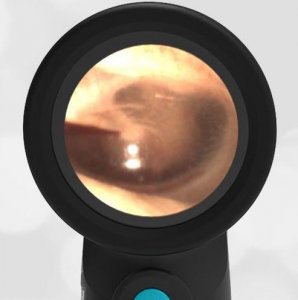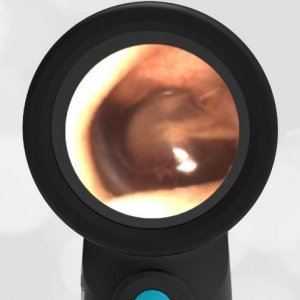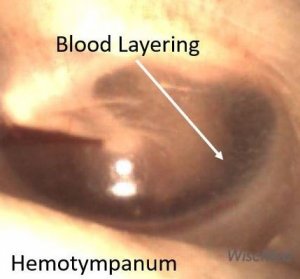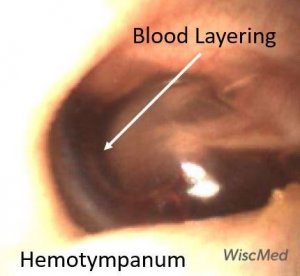
Bilateral Hemotympanum
A 15-year-old female presents to the ED (Emergency Department) with a chief complaint of epistaxis (nose bleed). She reports her nose began bleeding while at band practice, while playing the tuba, three hours earlier. The bleeding was quite profuse and did not stop despite several rounds of direct pressure. The teen became quite unsettled when she noticed her “eyes bleeding” so her parents brought her into the ED for evaluation. Aside from mild seasonal allergies and an occasional nose bleed associated with dry air, she has no other significant medical history.
In the ED, the patient was found to have active bilateral nose bleeding as well as a small amount of dried blood below her right eyelid. After placement of Afrin-soaked cotton balls into both nostrils and application of a nasal clamp for 30 minutes, the bleeding stopped. Following removal of the packing, prominent Kiesselbach’s plexuses were visible but her nasal passages were clear without clots or evidence of posterior bleeding. The patient expressed relief that the bleeding had stopped but noted that she was now experiencing slightly muffled hearing. Her Wispr exam revealed the cause for her new complaint. Here are images from both ears:
- Hemotympanum – Left Ear
- Hemotympanium – Right Ear
Wispr exam demonstrates bilateral hemotympanum without bulging or perforation.
While hemotympanum is well-known to occur in the setting of head trauma, a number of other scenarios may result in blood accumulating within the middle ear space. In our patient, the source of the hemotympanum is blood from the anterior nasal septum flowing posteriorly into the Eustachian Tube. As a conduit from the middle ear space to the nasopharynx, the Eustachian tube lacks a valve system to prevent such retrograde flow. While there are case reports of spontaneous epistaxis resulting in hemotympanum, it is much more likely to occur in the setting of nasal packing or prolonged bleeding. An interesting clue that our patient experienced such retrograde movement of blood was her additional report of bleeding from her eyes. This unusual complaint suggests there was enough pressure generated during her attempts to stop the epistaxis such that blood was forced up the nasolacrimal system and exited the tear ducts!
- Left Ear
- Right Ear
Here are the complete videos obtained of the left and right ear exam:
|
Left Ear Video |
Right Ear Video |











































































































































































































